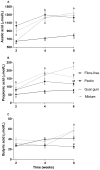High-fat diet reduces the formation of butyrate, but increases succinate, inflammation, liver fat and cholesterol in rats, while dietary fibre counteracts these effects
- PMID: 24236183
- PMCID: PMC3827442
- DOI: 10.1371/journal.pone.0080476
High-fat diet reduces the formation of butyrate, but increases succinate, inflammation, liver fat and cholesterol in rats, while dietary fibre counteracts these effects
Abstract
Introduction: Obesity is linked to type 2 diabetes and risk factors associated to the metabolic syndrome. Consumption of dietary fibres has been shown to have positive metabolic health effects, such as by increasing satiety, lowering blood glucose and cholesterol levels. These effects may be associated with short-chain fatty acids (SCFAs), particularly propionic and butyric acids, formed by microbial degradation of dietary fibres in colon, and by their capacity to reduce low-grade inflammation.
Objective: To investigate whether dietary fibres, giving rise to different SCFAs, would affect metabolic risk markers in low-fat and high-fat diets using a model with conventional rats for 2, 4 and 6 weeks.
Material and methods: Conventional rats were administered low-fat or high-fat diets, for 2, 4 or 6 weeks, supplemented with fermentable dietary fibres, giving rise to different SCFA patterns (pectin - acetic acid; guar gum - propionic acid; or a mixture - butyric acid). At the end of each experimental period, liver fat, cholesterol and triglycerides, serum and caecal SCFAs, plasma cholesterol, and inflammatory cytokines were analysed. The caecal microbiota was analysed after 6 weeks.
Results and discussion: Fermentable dietary fibre decreased weight gain, liver fat, cholesterol and triglyceride content, and changed the formation of SCFAs. The high-fat diet primarily reduced formation of SCFAs but, after a longer experimental period, the formation of propionic and acetic acids recovered. The concentration of succinic acid in the rats increased in high-fat diets with time, indicating harmful effect of high-fat consumption. The dietary fibre partly counteracted these harmful effects and reduced inflammation. Furthermore, the number of Bacteroides was higher with guar gum, while noticeably that of Akkermansia was highest with the fibre-free diet.
Conflict of interest statement
Figures










Similar articles
-
The physico-chemical properties of dietary fibre determine metabolic responses, short-chain Fatty Acid profiles and gut microbiota composition in rats fed low- and high-fat diets.PLoS One. 2015 May 14;10(5):e0127252. doi: 10.1371/journal.pone.0127252. eCollection 2015. PLoS One. 2015. PMID: 25973610 Free PMC article.
-
Effects of two whole-grain barley varieties on caecal SCFA, gut microbiota and plasma inflammatory markers in rats consuming low- and high-fat diets.Br J Nutr. 2015 May 28;113(10):1558-70. doi: 10.1017/S0007114515000793. Epub 2015 Apr 13. Br J Nutr. 2015. PMID: 25864430
-
Propionic and butyric acids, formed in the caecum of rats fed highly fermentable dietary fibre, are reflected in portal and aortic serum.Br J Nutr. 2013 Nov 14;110(9):1565-72. doi: 10.1017/S0007114513000809. Epub 2013 Mar 26. Br J Nutr. 2013. PMID: 23531375
-
The Role of Dietary Fibre in Modulating Gut Microbiota Dysbiosis in Patients with Type 2 Diabetes: A Systematic Review and Meta-Analysis of Randomised Controlled Trials.Nutrients. 2020 Oct 23;12(11):3239. doi: 10.3390/nu12113239. Nutrients. 2020. PMID: 33113929 Free PMC article.
-
Review article: dietary fibre-microbiota interactions.Aliment Pharmacol Ther. 2015 Jul;42(2):158-79. doi: 10.1111/apt.13248. Epub 2015 May 24. Aliment Pharmacol Ther. 2015. PMID: 26011307 Free PMC article. Review.
Cited by
-
Mucosal Interactions between Genetics, Diet, and Microbiome in Inflammatory Bowel Disease.Front Immunol. 2016 Aug 2;7:290. doi: 10.3389/fimmu.2016.00290. eCollection 2016. Front Immunol. 2016. PMID: 27531998 Free PMC article. Review.
-
The 2022 On-site Padua Days on Muscle and Mobility Medicine hosts the University of Florida Institute of Myology and the Wellstone Center, March 30 - April 3, 2022 at the University of Padua and Thermae of Euganean Hills, Padua, Italy: The collection of abstracts.Eur J Transl Myol. 2022 Mar 10;32(1):10440. doi: 10.4081/ejtm.2022.10440. Eur J Transl Myol. 2022. PMID: 35272451 Free PMC article.
-
Pectin in Metabolic Liver Disease.Nutrients. 2022 Dec 29;15(1):157. doi: 10.3390/nu15010157. Nutrients. 2022. PMID: 36615814 Free PMC article. Review.
-
Lactobacillus paracasei Jlus66 extenuate oxidative stress and inflammation via regulation of intestinal flora in rats with non alcoholic fatty liver disease.Food Sci Nutr. 2019 Jul 15;7(8):2636-2646. doi: 10.1002/fsn3.1118. eCollection 2019 Aug. Food Sci Nutr. 2019. PMID: 31428351 Free PMC article.
-
The Anti-Obesity Effect of Polysaccharide-Rich Red Algae (Gelidium amansii) Hot-Water Extracts in High-Fat Diet-Induced Obese Hamsters.Mar Drugs. 2019 Sep 13;17(9):532. doi: 10.3390/md17090532. Mar Drugs. 2019. PMID: 31540318 Free PMC article.
References
-
- Wang YC, McPherson K, Marsh T, Gortmaker SL, Brown M (2011) Health and economic burden of the projected obesity trends in the USA and the UK. Lancet 378: 815–825. - PubMed
-
- World Health Organization website. Obesity and overweight. http://www.who.int/mediacentre/factsheets/fs311/en/. Accessed 2013 May 16.
-
- Mahady SE, George J (2012) Management of nonalcoholic steatohepatitis: an evidence-based approach. Clinics in Liver Disease 16: 631–645. - PubMed
-
- Anderson JW, Baird P, Davis RH Jr, Ferreri S, Knudtson M, et al. (2009) Health benefits of dietary fiber. Nutr Rev 67: 188–205. - PubMed
-
- Schulze MB, Schulz M, Heidemann C, Schienkiewitz A, Hoffmann K, et al. (2007) Fiber and magnesium intake and incidence of type 2 diabetes: a prospective study and meta-analysis. Arch Intern Med 167: 956–965. - PubMed
Publication types
MeSH terms
Substances
LinkOut - more resources
Full Text Sources
Other Literature Sources
Medical

